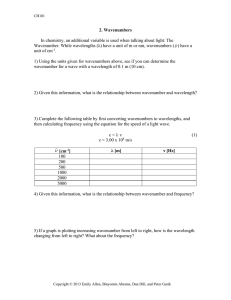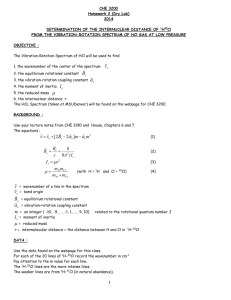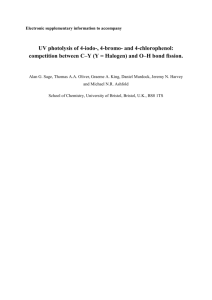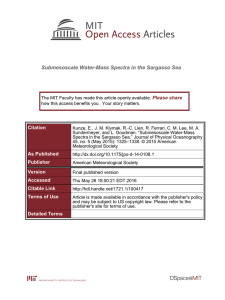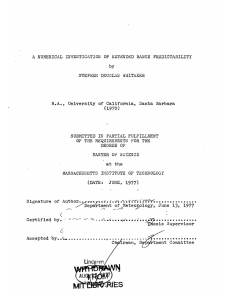Patricia_Final_Pres - MPO581
advertisement
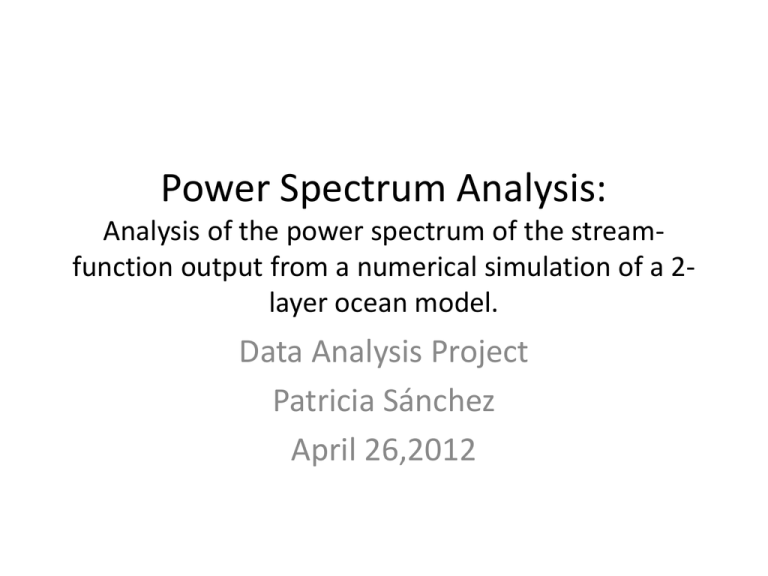
Power Spectrum Analysis: Analysis of the power spectrum of the streamfunction output from a numerical simulation of a 2layer ocean model. Data Analysis Project Patricia Sánchez April 26,2012 Motivation • We have study Q-G systems – Many assumptions – Leads to set of equations of motions – How to solve them??? – Numerical Solutions • Quantify the Instabilities – How they vary in time… • GFD2 Project !! Background • Dataset: – Numerical Model: solve the Q-G PV equation. • Two-layer with thickness H1 and H2 • Uniform background current of speed Uo in top layer and 0 in the bottom layer • Output: PSI ψ(x,y,t) of each layer. Layer #1 Longitude (256) Latitude (512 gridpoints) Height Method • Power Spectrum: – An often more useful alternative is the power spectral density (PSD), which describes how the power of a signal or time series is distributed with frequency. Here power can be the actual physical power, or more often, for convenience with abstract signals, can be defined as the squared value of the signal, – Fourier Transform has units of u×time – power spectral density has units of u2×time2/time Time Series Fourier Transform Power Spectral Density (freq) Experiment • What do we want? • Previous work: The estimation of the frequency-wavenumber power spectral density is of considerable importance in the analysis of propagating waves by an array of sensors . (Capon,J, 1969) • Analyze the power spectrum density in terms of wavenumber. Time Series of PSI map Example: http://www.weizmann.ac.il/es erpages/kaspi/jets/jas07_1.ht m 1. Select a snapshot (time) 2. Select spatial latitude Interpretation Power Density Spectrum in terms of wavenumber Cumulative power Data: Output • PSI ψ(x,y,t) snapshots of each layer. “Raw Data” – Snapshots: every 100 days • Animation Time:100 Time:2400 Time:17000 Steady State Small Scale features Large Scale features but with small scale ψ(x,y,t) Stream function Animation Power density Spectrum Time:100 Time:9100 Time:15100 Key Features: • Power Spectrum analysis at each snapshot • Variation in amplitude and slope at different times. • Almost all the power (variance) is at “lower” wavenumber. • But, how “low” are these dominant wavenumbers? • Next…. Next step: • Since we know that most of the power is concentrated in lower wavenumbers… • Analyze the wavenumber where the power spectrum is maximum. • How changes over time? Time Series Of a Signal Power Density Spectrum Analyze the maximum wavenumber Analysis of “Kmax” results • 2nd Step: Evaluate the “Kmax” • Remember, what do we want… • Not clear interpretation of the results . • Too much variability • We need to define a new way/method to analyze the data How to Interpret the Result: • From power spectrum, we can see: 1. It changes in amplitude 2. It changes where is the “kmax” and how steep is the slope Time:15100 Refine the results • From 1: – Calculate how the total (maximum) cumulative power changes with time. • From 2: – Approach: Locate the wavenumber at which half the power is in lower wavenumbers. Cumulative Power • In an analogy to the energy signals, let us define a function that would give us some indication of the relative power contributions at various frequencies, as Sf (ω), or in this experiment, wavenumbers Sk(k). Normalized From 0-1 ½ of all cumulative power Wavenumber 1-50 Cumulative Power Time:5100 Time:15100 Time series of total of cumulative Power • Tendency: to decrease for the first half of the time series. • When the flow is more perturbed the maximum cumulative power increases. K1/2 Analysis • The wavenumber at which half the power is in lower wavenumbers) • We know that the most of the total variance is contributed by the “lower” wavenumbers. • We want to quantify how of these wavenumbers vary with time. • With this result, we could guess what is the scale of the flow. • It includes the signal (that your eye already told you so you believe it), but clean and objective Summary • Power Spectrum Density: – Transform the signal from space (x,y t) domain to frequency/wavenumber domain. – The power spectrum show a concentration of power at low frequencies. – It varies in amplitude and slope. – Hypothesis: “The small scale perturbations could have more power than the larger scale features” (Kamenkovich) • Cumulative Power Spectrum: – In snapshot: shows how “low” wavenumber dominates – In time series: • We could determine the scale of the signal • Future work: – Apply same analysis for: • a different latitude to compare how different are the results. • Instead of latitude-cross, try with longitude-cross, i.e. meridional wavenumber l analysis. • Another experiment (model output) – We could determine the fastest growing mode.
